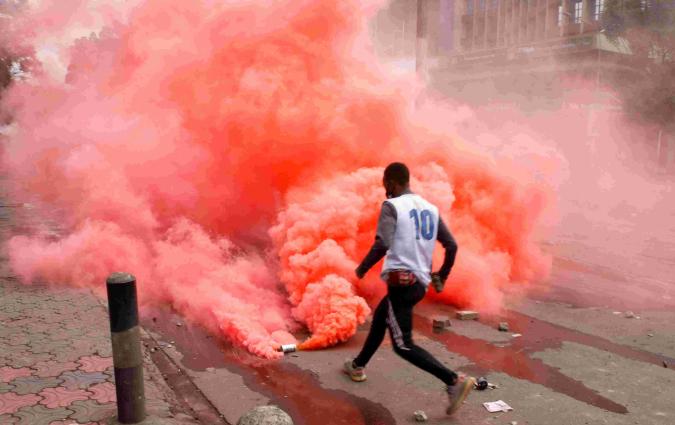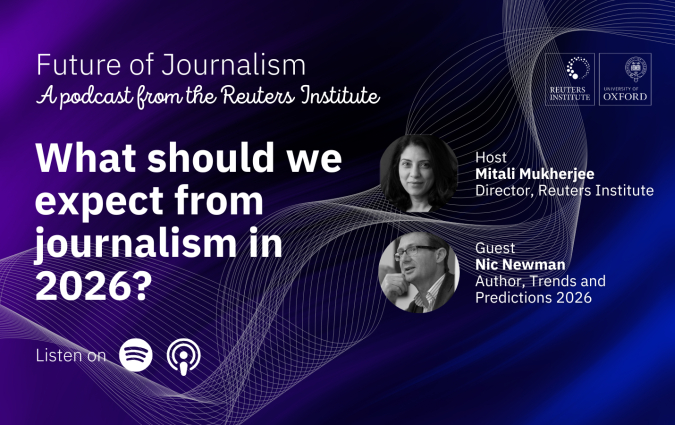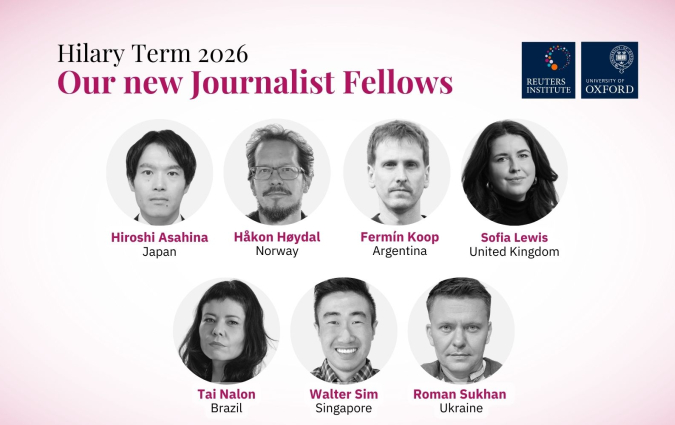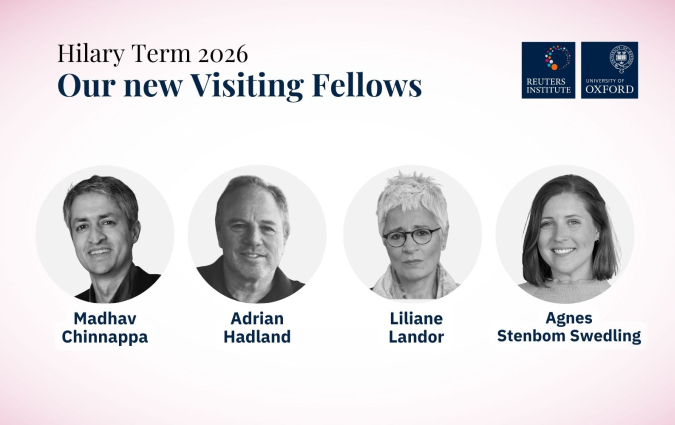Reuters Institute presentations at the American Political Science Association conference

Credit: kanonsky / Canva
This year's 117th 2021 APSA Annual Meeting takes place from 30 September to 3 October 2021 bringing more than 2,000 political scientists, leaders, and professionals together in Seattle, with a virtual option also available. Reuters Institute researchers will be sharing papers on subjects including news consumption and voter engagement during the Iowa caucuses, misinformation in India and the relationship between trust in news and impartial journalism.
Mobilisation, inequality, and news communities in the 2020 Iowa caucuses
Benjamin Toff, Ruth Palmer
Nearly three decades ago, Rosenstone and Hansen (1993, p. 5) argued in their groundbreaking book on political mobilisation that “people participate in politics not so much because of who they are but because of the political choices and incentives they are offered.” Even as the study of political behaviour has turned its focus to partisan identity (e.g., Mason 2018), the mobilizing effects of campaign activity remain arguably as important as ever. Parties and candidates have adopted increasingly sophisticated digital communication technologies, voter file databases, and targeted strategies for mobilising niche segments of the public (Gerber and Green 2000; Green and Schwam-Baird 2016; Nickerson and Rogers 2014; Nielsen 2012). Most existing research on mobilisation has focused exclusively on their impact from the vantage point of the campaigns who make decisions about deploying them. We know little, however, about the experience of voters and nonvoters who are on the receiving end of such efforts—or are excluded altogether—and what those experiences entail.
This inductive study focuses on the perspectives of the engaged and disengaged publics during in the 2020 Iowa caucuses, which has served as the first electoral contest in the US presidential nomination process since the 1970s. The study is based on in-depth, in-person qualitative interviews (N = 70) conducted with a range of residents in the state both during the summer of 2019 and in the days immediately following the caucuses. Part of a larger project examining the drivers of news consumption habits, participants were selected based on their prior self-reported media habits with a balance between “news avoiders” (those who consume little to no news at all) and “news lovers” (those who access news dozens of times per day). The resulting variation among participants in the study, which loosely tracks divides along lines of socioeconomic class, offers a unique window into the divergent experiences of distinct groups of Iowans. Who gets mobilised and how do such processes play out in the contemporary digital media environment?
While some spoke fondly about the intense and sustained attention they and their fellow citizens receive as caucus-goers, such attitudes were hardly universal. Despite the state’s reputation for in-person, retail politicking, most described the campaigns in strikingly detached and mediated terms—as a colourful yet fleeting spectacle they watched from afar. Among the highly engaged, some did belong to circles in which mingling with candidates and campaign staff was commonplace and enjoyed, but most attributed their own involvement less to campaign outreach and more to norms about voting as a civic duty, social influences and obligations, or a combination of these forces. The contrast with the disengaged public was often stark. Whereas news lovers often recounted (sometimes with irritation) the barrage of appeals they received from campaigns in the form of personalised telephone calls, mailings, and advertisements, among news avoiders, several reported no contacts at all from campaigns and only a vague awareness the caucuses were even occurring. Some news avoiders struggled to attend caucuses due to structural barriers imposed by the caucus’s unique and time-intensive format—an indication that many campaigns may still be struggling to reach the very voters they strive to mobilise.
Our findings point to two important insights that extend previous work. First, the study illustrates a concern raised in previous studies about whether more sophisticated digital modes of mobilisation might stratify the public along socioeconomic lines. Previous research on digital mobilisation often emphasised its potential to deepen opportunities mainly for those already pre-disposed to participate and leave others behind (Schlozman, Verba, and Brady 2010). Although stratification online largely tracks patterns offline (Boulianne 2009, Oser, Hooghe, and Marien 2012), concerns have been raised about whether an over-reliance on digital lists may prompt campaigns to increasingly train their focus on segments of the public who are already most politically active and most likely to respond favorably to campaign appeals (Krueger 2006). Our findings lend some evidence to these concerns.
Session: Rallies, Protests, and Mobilisation (Political Communication division)
Exploring the relationship between trust in news and impartial journalism
Camila Mont'Alverne, Sumitra Badrinathan, Amy Ross Arguedas, Benjamin Toff, Richard Fletcher, Rasmus Kleis Nielsen
Many countries have seen sharp declines in trust in the news in recent years (Newman et al., 2020). However, we currently know little about what has caused these declines, and our understanding of what factors influence trust in the news—and how this varies by country—remains limited. Given that many of those with low trust often attribute it to what they see as biased coverage (Newman and Fletcher, 2018), it is possible people’s attitudes towards impartiality are linked to trust in the news.
In recent years the growth of digital technology has dramatically increased the sheer volume of available news and information (Neuman, 2016). This has simultaneously created more opportunities for people to selectively expose themselves to news and information aligned with their own point of view, while also making it easier to encounter news and information that challenges it. For decades, impartiality has been seen by many as a key tenet of the journalistic profession in many countries (Hanitzsch, 2007; Tuchman, 1972). But for some practitioners, the easy availability of diverse and sometimes nuanced perspectives raises difficult questions about the value of impartialty, particularly if realised as the dualistic indexing of elite perspectives (the “strategic ritual of objectivity” that can result in false balance or he-said-she-said journalism). For other practitioners, impartiality has never been more precious, as people worry about polarisation and many struggle to make sense of complex debates and contradictory information.
This study takes a mixed-methods approach to investigating whether people’s preference for “news with a point of view,” in contrast to “impartial” journalism, is associated with different levels of trust in the news.
The first part draws on in-depth practitioner interviews conducted in 2020 with 83 journalists and senior managers in newsrooms across three countries (Brazil, UK, and USA). Our interviews show how practitioners themselves can be divided and conflicted. Some think news with a point of view is the best way to meet the industry's challenges; others defend more conventional notions of impartiality as crucial to sustaining trust. The two views are not always in absolute opposition, but reflect different stances. Practitioners in the first group argue that presenting a point of view is welcome both from market and transparency perspectives. They claim to offer news that fills a gap in the public sphere by providing valuable analysis and interpretation of complex events. For them, presenting a point of view means sticking up for values and being forthright about news judgments, which builds trust and loyalty. Conversely, journalists in the second group say that moving away from impartiality is not sustainable nor desirable. They suggest journalists' first mission is informing citizens and letting them form their own opinions. For them, news with a more explicit point of view constitutes a breach of professional journalistic norms and is not economically feasible because it would be impossible to please all audiences all the time.
The second part focuses on news audience perspectives, using survey data from the Reuters Institute’s 2020 Digital News Report (N = 80,000), which spans 40 markets across the Global North and South. In this part, we descriptively explore factors associated with individual-level preferences for news with a point of view, with a particular focus on the associations between trust in the news overall and trust in the news people actually use. The analysis will help shed light on whether the different, partially conflicting theories of how trust in news identified through our practitioner interviews are backed up by audience data. In this second part, we examine some of the many possible mechanisms underlying associations between trust and preferences for news with a point of view. For example, people with higher trust in the news might welcome the idea that it promotes a range of points of view because they trust it will be done responsibly and to the benefit of society. But conversely, it is also possible that people with higher trust might prefer impartiality because they trust that journalists will fairly balance competing views. These mechanisms likely play out differently depending on the nature of the media system.
In the final analysis we combine the interview and survey data to explore possible differences in how journalists and citizens think about trust in the media. Our findings will therefore have implications for how perceptions of news organisations’ coverage impact their relationships with audiences and for challenges around building trust while adhering to conventional journalism practices.
Session: News bias, representation and accountability (Political communication division)
Leveraging religiosity against COVID-19 misinformation: An experiment in India
Sumitra Badrinathan, Simon Chauchard
Was COVID-19 made in a lab? Are minority communities conspiring to spread the virus? Can herbal tonics ward the virus away? These are examples of viral hoaxes surrounding COVID-19 in developing countries such as India, Tanzania and Madagascar. Beliefs in miracle cures are dangerous if even a fraction of those succumbing to them ignore best practices like social distancing (Bridgman et al. 2020). Beliefs in narratives that scapegoat minorities can increase malice between social groups, paving the way for polarisation and violence (Pundir 2020).
In this experiment, we focus on a common human vulnerability to misinformation, motivated reasoning (Nyhan and Reifler 2012; Taber and Lodge 2006), but argue that a key factor of belief in misinformation in developing countries is religiosity. While largely overlooked in the emerging empirical literature on misinformation, religion plays a central role in many cultures in promoting the popularity of miracle cures and home remedies, fuelled by an inclination to uphold ancient religious wisdom (Dore 2020). In addition, beliefs in narratives that scapegoat religious minorities are often touted by religious nationalist political parties with majoritarian agendas (Narayanan et al. 2019).
How can we effectively correct misinformed beliefs, particularly when they are rooted in tradition and difficult to change? We posit that people with high levels of religiosity endorse miracle cure misinformation, while those who support religious nationalist parties endorse conspiratorial misinformation. We theorise that such endorsement arises from pressures to conform to the ingroup (religious or partisan), and from dissonance between religious priors and new, scientific information. We then hypothesise that relieving the dissonance between priors and new information, or relieving conformity pressures caused by shared group identity, can reduce beliefs in misinformation.
We test these hypotheses with an online experiment in India, a country with deep religious beliefs, religious nationalist parties, and misinformation that has resulted in violence and deaths (N=1600). Treatment group respondents are shown hypothetical conversations on WhatsApp, a conduit popular for its intimacy, homophilic groups, and consequently, the viral proliferation of falsehoods (Davies 2020). Respondents read conversations with a misinformation stimulus and targeted correction designed to reduce dissonance or conformity pressures. Our corrections draw on surprising sources, a technique previously shown to make corrections stick (Berinsky 2017). Just as when Democrats contradicting Democrats is effective (Porter and Wood 2019), we use the unlikely source of Hindu religious texts to correct religiously-motivated misinformation. In addition, we provide corrections to group-congruent misinformation from ingroup partisan and religious members, who cite group norms to verify false information. We measure the effect of these treatments on perceived accuracy of stories on two issues: COVID-19 conspiracy theories and unproven miracle cures. For our outcome measure, each respondent is asked to classify 12 headlines as true or false, on a 4-point scale.
Our results confirm the impact of religiosity: highly religious individuals believe twice as many misinformation stories relative to less religious individuals. Further, we find support for our hypotheses: respondents receiving experimental treatments are significantly more likely to be able to discern true from false headlines. We also demonstrate that the specific mechanism for belief in misinformation matters. We find that increasing the salience of group norms about accurate sharing decreases belief in conspiracy theories, while highlighting religious dissonance by using Hindu sacred texts decreases beliefs in miracle cures. Importantly, we show improvements in ability to detect misinformation that extend beyond the specific misinformation stimulus used in our treatments. Respondents are able to learn from the treatments and accurately identify additional falsehoods as well.
In a country where rumours can result in social conflict and violence, we provide a unique strategy to temper the human cost of misinformation in India. Pre-registration for this experiment can be found at: https://bit.ly/36jupSV
Session: Psychology of COVID-19
Who believes misinformation? A profile of vulnerability to false news in India
Simon Chauchard, Sumitra Badrinathan
Misinformation has deleterious effects on citizens across the world, from altering attitudes, increasing polarisation, to affecting voting behaviour (Jerit and Zhao 2020). But it can have an outsized impact in developing countries because of lower rates of formal education, decreased literacy, and new but unfamiliar internet users. What does the demographic profile of the average user vulnerable to misinformation in such contexts look like?
We answer this question in the context of India, a country with an exponentially-growing population of internet users and where beliefs in misinformation have led to violence, social conflict, and murder (Perrigo 2019; McLaughlin 2018). Research in American settings finds that older people, those ideologically aligned to the right-wing, and those with low levels of digital literacy are most vulnerable to falsehoods (Grinberg et al. 2019; Munger et al. 2018). But expecting these outcomes is not a forgone conclusion in the case of India, where the mechanisms for the spread of rumours, the norms that surround information sharing, and the platforms they are shared on are dissimilar from Western contexts.
In this project, we draw on data from three surveys conducted over two years in India to paint a profile of vulnerability to misinformation. Our samples cover diverse demographics, methods of sampling, time periods, and locations. Using two online studies and one face-to face survey, we show that the correlates of misinformation in India are a stark contrast from those in Western democracies. First, we find that age is negatively correlated with vulnerability to misinformation, while digital literacy is positively correlated. Further, while men and women are equally susceptible to falsehoods, men demonstrate higher levels of confidence in their views about the veracity of stories. In addition, while right and left-wing partisans are equally susceptible as well, right-wing partisans seem to have stronger tools to argue away counter-attitudinal information. In other words, they engage in partisan motivated reasoning to a greater extent and are less likely to learn from interventions designed to mitigate beliefs in misinformation. Across all our studies, education, often seen as a proxy for political sophistication (Wittenberg and Berinsky 2020), has no effect on propensity to consume false stories. Finally, moving beyond demographics, we underscore the importance of religiosity as an unexplored covariate that predicts beliefs in misinformation. Highly religious respondents are twice as likely to be vulnerable to false stories relative to less religious respondents, highlighting the link between religious beliefs and health misinformation as well as conspiracy theories scapegoating religious minorities. We demonstrate that religious motivated reasoning is an even stronger predictor than partisanship in this context.
Our results have consequential implications. Identifying the populations most vulnerable to misinformation can help academics, policymakers, and tech platforms design targeted interventions to slow its uptake. This study also aims to provoke a deeper understanding of the mechanisms for vulnerability to misinformation in developing contexts, along with a discussion of why and how these mechanisms differ from Western countries.
Session: Misinformed? who, how, and why
Nudging news consumption: Evidence from a survey experiment in the UK
The consumption of false or misleading news represents a key challenge for societies. The need for consuming and disseminating trustworthy news has become more apparent with the coronavirus pandemic. In this study, we conduct a randomized, pre-registered online survey experiment in the UK (N=3,061) to test whether a social norm-based nudge on news media trust can be used to influence individuals’ choice of news about the coronavirus pandemic. Our analysis shows that using a social norm nudge did not significantly reduce the likelihood of selecting a news article containing false information about the origins of coronavirus. However, it slightly increased the selection of a news article from the most trusted news sources, such as the BBC. Finally, the effect of the nudge on choosing highly trusted news sources is stronger among subjects who already trust the news if compared to those with low levels of trust. Our findings provide some support for the idea that social norm-based nudges can be used to increase the likelihood of consuming more highly trusted news sources. However the effects are small and limited. Although promoting more trusted news sources is sometimes seen as an important step in combatting misinformation, our findings highlight that nudging small numbers of people that would otherwise use moderately trusted sources towards more highly trusted sources may have little effect on the consumption of false information.
Session: Fact-checking and misinformation correction
The effect of VAAs on voting behavior: A field experiment in Turkey
Simge Andı, Ali Çarkoğlu, and Susan Banducci
Voting Advice Applications (VAAs) are used in elections across the globe, and offer voters non-partisan information about political parties, candidates, and policy issues. Several studies suggest that VAAs affect vote choice as well as political knowledge. However, most of these studies rely on convenience samples, cannot account for selection bias in the exposure to VAAs, and do not examine the long-term effects of VAAs. In this study, we present results from a randomized field experiment that evaluates the effects of a VAA intervention on voter knowledge and candidate choice. We use a representative sample of Turkish adults who were interviewed before and after the 2019 local elections in Istanbul. Our analysis demonstrates that the VAA intervention increases how informed citizens feel about electoral candidates, ultimately influencing their candidate choice. These effects are, however, short-term, and they dissipate within 2 months. Our findings indicate that VAAs may be useful tools with which to inform citizens and influence voting behavior in the short-run.
Session: Field and natural experiments on electoral behavior







